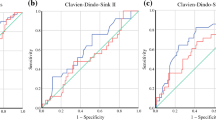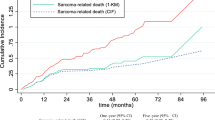Abstract
Background
Obesity is a growing epidemic and has been associated with an increased frequency of complications after various surgical procedures. Studies also have shown adipose tissue to promote a microenvironment favorable for tumor growth. Additionally, the relationship between obesity and prognosis of soft tissue sarcomas has yet to be evaluated.
Questions/purposes
We sought to assess if (1) obesity affects survival outcomes (local recurrence, distant metastasis, and death attributable to disease) in patients with extremity soft tissue sarcomas; and (2) whether obesity affected wound healing and other surgical complications after treatment.
Methods
A BMI of 30 kg/m2 or greater was used to define obesity. Querying our prospective database between 2001 and 2008, we identified 397 patients for the study; 154 were obese and 243 were not obese. Mean followup was 4.5 years (SD, 3.1 years) in the obese group and 3.9 years (SD, 3.2 years) in the nonobese group; the group with a BMI of 30 kg/m2 or greater had a higher proportion of patients with followups of at least 2 years compared with the group with a BMI less than 30 kg/m2 (76% versus 62%). Outcomes, including local recurrence, distant metastasis, and overall survival, were analyzed after patients were stratified by BMI. Multivariable survival models were used to identify independent predictors of survival outcomes. Wilcoxon rank sum test was used to compare continuous variables. Based on the accrual interval of 8 years, the additional followup of 5 years after data collection, and the median survival time for the patients with a BMI less than 30 kg/m2 of 3 years, we were able to detect true median survival times in the patients with a BMI of 30 kg/m2 of 2.2 years or less with 80% power and type I error rate of 0.05.
Results
Patients who were obese had similar survival outcomes and wound complication rates when compared with their nonobese counterparts. Patients who were obese were more likely to have lower-grade tumors (31% versus 20%; p = 0.021) and additional comorbidities including diabetes mellitus (26% versus 7%; p < 0.001), hypertension (63% versus 38%; p < 0.001), and smoking (49% versus 37%; p = 0.027). Regression analysis confirmed that even after accounting for certain tumor characteristics and comorbidities, obesity did not serve as an independent risk factor in affecting survival outcomes.
Conclusions
Although the prevalence of obesity continues to increase and lead to many negative health consequences, it does not appear to adversely affect survival, local recurrence, or wound complication rates for patients with extremity soft tissue sarcomas.
Level of Evidence
Level III, therapeutic study. See the Instructions for Authors for a complete description of levels of evidence.



Similar content being viewed by others

References
Atek M, Traissac P, El Ati J, Laid Y, Aounallah-Skhiri H, Eymard-Duvernay S, Mezimeche N, Bougatef S, Beji C, Boutekdjiret L, Martin-Prevel Y, Lebcir H, Gartner A, Kolsteren P, Delpeuch F, Romdhane HB, Maire B. Obesity and association with area of residence, gender and socio-economic factors in Algerian and Tunisian adults. PloS One. 2013;8:e75640.
Bifulco M, Pisanti S. “Adiponcosis”: a new term to name the obesity and cancer link. J Clin Endocrinol Metab. 2013;98:4664–4665.
Boeing H. Obesity and cancer: the update 2013. Best Pract Res Clin Endocrinol Metab. 2013;27:219–227.
Bowne WB, Antonescu CR, Leung DH, Katz SC, Hawkins WG, Woodruff JM, Brennan MF, Lewis JJ. Dermatofibrosarcoma protuberans: a clinicopathologic analysis of patients treated and followed at a single institution. Cancer. 2000;88:2711–2720.
Catalan V, Gomez-Ambrosi J, Rodriguez A, Fruhbeck G. Adipose tissue immunity and cancer. Front Physiol. 2013;4:275.
Chee YH, Teoh KH, Sabnis BM, Ballantyne JA, Brenkel IJ. Total hip replacement in morbidly obese patients with osteoarthritis: results of a prospectively matched study. J Bone Joint Surg Br. 2010;92:1066–1071.
Dowsey MM, Liew D, Stoney JD, Choong PF. The impact of obesity on weight change and outcomes at 12 months in patients undergoing total hip arthroplasty. Med J Aust. 2010;193:17–21.
Edge SB. AJCC Cancer Staging Manual. New York, NY; Springer; 2009.
Elson LC, Barr CJ, Chandran SE, Hansen VJ, Malchau H, Kwon YM. Are morbidly obese patients undergoing total hip arthroplasty at an increased risk for component malpositioning? J Arthroplasty. 2013;28:41–44.
Fine JP, Gray RJ. A proportional hazards model for the subdistribution of a competing risk. J Am Stat Assoc. 1999;94:496–509.
Flegal KM, Carroll MD, Ogden CL, Curtin LR. Prevalence and trends in obesity among US adults, 1999–2008. JAMA. 2010;303:235–241.
Geller DS, Hornicek FJ, Mankin HJ, Raskin KA. Soft tissue sarcoma resection volume associated with wound-healing complications. Clin Orthop Relat Res. 2007;459:182–185.
GETFITTN. Get Fit Tennessee 2013. Available at: https://www.getfit.tn.gov/obesity.aspx. Accessed March 8, 2014.
Gooley TA, Leisenring W, Crowley J, Storer BE. Estimation of failure probabilities in the presence of competing risks: new representations of old estimators. Stat Med. 1999;18:695–706.
Gray RJ. A Class of K-sample tests for comparing the cumulative incidence of a competing risk. Ann Statist. 1988;16:1141–1154.
Gupta AK, Chalmers PN, Rahman Z, Bruce B, Harris JD, McCormick F, Abrams GD, Nicholson GP. Reverse total shoulder arthroplasty in patients of varying body mass index. J Shoulder Elbow Surg. 2014;23:35–42.
Haverkamp D, Klinkenbijl MN, Somford MP, Albers GH, van der Vis HM. Obesity in total hip arthroplasty: does it really matter? A meta-analysis. Acta Orthop. 2011;82:417–422.
Jayawardena R, Byrne NM, Soares MJ, Katulanda P, Hills AP. Prevalence, Trends and associated socio-economic factors of obesity in South Asia. Obes Facts. 2013;6:405–414.
Kaplan EL, Meier P. Nonparametric estimation from incomplete observations. J Am Stat Assoc. 1958;53:457–481.
Krane MK, Allaix ME, Zoccali M, Umanskiy K, Rubin MA, Villa A, Hurst RD, Fichera A. Does morbid obesity change outcomes after laparoscopic surgery for inflammatory bowel disease? Review of 626 consecutive cases. J Am Coll Surg. 2013;216:986–996.
Lawlor DA, Lean M, Sattar N. ABC of obesity: obesity and vascular disease. BMJ. 2006;333:1060–1063.
Maradit Kremers H, Visscher SL, Kremers WK, Naessens JM, Lewallen DG. Obesity increases length of stay and direct medical costs in total hip arthroplasty. Clin Orthop Relat Res. 2014;472:1232–1239.
Motaghedi R, Bae JJ, Memtsoudis SG, Kim DH, Beathe JC, Paroli L, Yadeau JT, Gordon MA, Maalouf DB, Lin Y, Ma Y, Cunningham-Rundles S, Liu SS. Association of obesity with inflammation and pain after total hip arthroplasty. Clin Orthop Relat Res. 2014;472:142–1448.
Odum SM, Springer BD, Dennos AC, Fehring TK. National obesity trends in total knee arthroplasty. J Arthroplasty. 2013;28:148–151.
Park JW, Lim SW, Choi HS, Jeong SY, Oh JH, Lim SB. The impact of obesity on outcomes of laparoscopic surgery for colorectal cancer in Asians. Surg Endosc. 2010;24:1679–1685.
Protani M, Coory M, Martin JH. Effect of obesity on survival of women with breast cancer: systematic review and meta-analysis. Breast Cancer Res Treat. 2010;123:627–635.
Rajgopal R, Martin R, Howard JL, Somerville L, MacDonald SJ, Bourne R. Outcomes and complications of total hip replacement in super-obese patients. Bone Joint J. 2013;95:758–763.
Ramos-Nino ME. The role of chronic inflammation in obesity-associated cancers. ISRN Oncol. 2013;2013:697521.
Sinicrope FA, Foster NR, Sargent DJ, O’Connell MJ, Rankin C. Obesity is an independent prognostic variable in colon cancer survivors. Clin Cancer Res. 2010;16:1884–1893.
Tavani A, Soler M, La Vecchia C, Negri E, Gallus S, Franceschi S. Body weight and risk of soft-tissue sarcoma. Br J Cancer. 1999;81:890–892.
Wang Z, Yang L, Jiang Y, Ling ZQ, Li Z, Cheng Y, Huang H, Wang L, Pan Y, Wang Z, Yan X, Chen Y. High fat diet induces formation of spontaneous liposarcoma in mouse adipose tissue with overexpression of interleukin 22. PloS One. 2011;6:e23737.
Watson SE, Li Z, Tu W, Jalou H, Brubaker JL, Gupta S, Huber JN, Carroll A, Hannon TS. Obstructive sleep apnoea in obese adolescents and cardiometabolic risk markers. Pediatr Obes. 2013 Sept 17. [Epub ahead of print].
Williams SC. Link between obesity and cancer. Proc Natl Acad Sci USA. 2013;110:8753–8754.
Author information
Authors and Affiliations
Corresponding author
Additional information
Each author certifies that he or she, or a member of his or her immediate family, has no funding or commercial associations (eg, consultancies, stock ownership, equity interest, patent/licensing arrangements, etc) that might pose a conflict of interest in connection with the submitted article.
All ICMJE Conflict of Interest Forms for authors and Clinical Orthopaedics and Related Research editors and board members are on file with the publication and can be viewed on request.
Each author certifies that his or her institution approved the human protocol for this investigation, that all investigations were conducted in conformity with ethical principles of research, and that informed consent for participation in the study was obtained.
About this article
Cite this article
Alamanda, V.K., Moore, D.C., Song, Y. et al. Obesity Does Not Affect Survival Outcomes in Extremity Soft Tissue Sarcoma. Clin Orthop Relat Res 472, 2799–2806 (2014). https://doi.org/10.1007/s11999-014-3714-7
Received:
Accepted:
Published:
Issue Date:
DOI: https://doi.org/10.1007/s11999-014-3714-7



